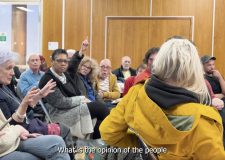Brighton and Hove protesters join fracking blockade in Balcombe
Protesters from Brighton and Hove joined a blockade in Balcombe to keep lorries delivering equipment for fracking company Cuadrilla.
Last week the Environment Agency granted a mining waste permit to Cuadrilla covering the management of waste from a planned exploratory borehole to test for oil and gas reserves.
Opponents fear that the test drilling could lead to Cuadrilla fracking for gas at the site.
The Chancellor, George Osborne, recently announced tax breaks for the controversial practice.
Fracking, or hydraulic fracturing, involves pumping large quantities of water, sand and chemicals into the ground to extract gas.
Critics say that chemicals such as hydrochloric acid pollute the water supplies and that the practice was responsible for a number of small earthquakes in the Blackpool area.
At Balcombe the potential fracking site is near one of the main reservoirs for Sussex and close to the railway line between London and Brighton.
The practice also uses large quantities of water and critics have cited the recent history of water shortages and hosepipe bans in the area.
Up to 100 protesters took part in the protest yesterday, with a bus load setting off from Brighton first thing.
One of the Cuadrilla lorries had a brake cable cut. This was repaired.
There was a peaceful stand-off with Sussex Police who decided against forcibly moving on the protesters.
No test drilling is permitted before Monday (29 July) and further protests are expected, with Friends of the Earth playing a key part.
Brenda Pollack, regional campaigner for Friends of the Earth South East, said: “Shale gas and oil are not the solution to our energy challenges.
“They threaten local communities, pollute our atmosphere and there’s plenty of evidence they won’t bring down fuel prices.
“It’s time to end the nation’s costly addiction to dirty fossil fuels and build a clean future based on energy efficiency and harnessing the power of the wind, waves and sun.”
Cuadrilla said that its processes were safe and that water supply pollution in America were the result of poor practice.




















